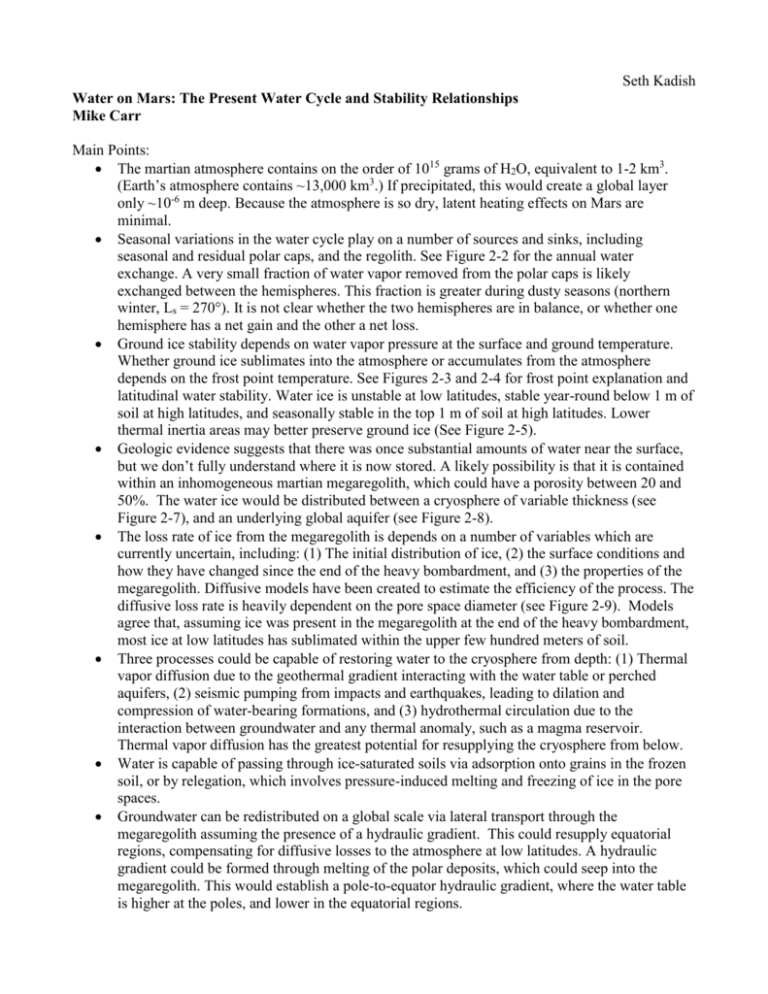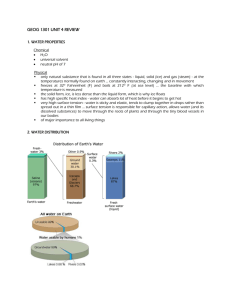Carr_Water_on_Mars
advertisement

Seth Kadish Water on Mars: The Present Water Cycle and Stability Relationships Mike Carr Main Points: The martian atmosphere contains on the order of 1015 grams of H2O, equivalent to 1-2 km3. (Earth’s atmosphere contains ~13,000 km3.) If precipitated, this would create a global layer only ~10-6 m deep. Because the atmosphere is so dry, latent heating effects on Mars are minimal. Seasonal variations in the water cycle play on a number of sources and sinks, including seasonal and residual polar caps, and the regolith. See Figure 2-2 for the annual water exchange. A very small fraction of water vapor removed from the polar caps is likely exchanged between the hemispheres. This fraction is greater during dusty seasons (northern winter, Ls = 270°). It is not clear whether the two hemispheres are in balance, or whether one hemisphere has a net gain and the other a net loss. Ground ice stability depends on water vapor pressure at the surface and ground temperature. Whether ground ice sublimates into the atmosphere or accumulates from the atmosphere depends on the frost point temperature. See Figures 2-3 and 2-4 for frost point explanation and latitudinal water stability. Water ice is unstable at low latitudes, stable year-round below 1 m of soil at high latitudes, and seasonally stable in the top 1 m of soil at high latitudes. Lower thermal inertia areas may better preserve ground ice (See Figure 2-5). Geologic evidence suggests that there was once substantial amounts of water near the surface, but we don’t fully understand where it is now stored. A likely possibility is that it is contained within an inhomogeneous martian megaregolith, which could have a porosity between 20 and 50%. The water ice would be distributed between a cryosphere of variable thickness (see Figure 2-7), and an underlying global aquifer (see Figure 2-8). The loss rate of ice from the megaregolith is depends on a number of variables which are currently uncertain, including: (1) The initial distribution of ice, (2) the surface conditions and how they have changed since the end of the heavy bombardment, and (3) the properties of the megaregolith. Diffusive models have been created to estimate the efficiency of the process. The diffusive loss rate is heavily dependent on the pore space diameter (see Figure 2-9). Models agree that, assuming ice was present in the megaregolith at the end of the heavy bombardment, most ice at low latitudes has sublimated within the upper few hundred meters of soil. Three processes could be capable of restoring water to the cryosphere from depth: (1) Thermal vapor diffusion due to the geothermal gradient interacting with the water table or perched aquifers, (2) seismic pumping from impacts and earthquakes, leading to dilation and compression of water-bearing formations, and (3) hydrothermal circulation due to the interaction between groundwater and any thermal anomaly, such as a magma reservoir. Thermal vapor diffusion has the greatest potential for resupplying the cryosphere from below. Water is capable of passing through ice-saturated soils via adsorption onto grains in the frozen soil, or by relegation, which involves pressure-induced melting and freezing of ice in the pore spaces. Groundwater can be redistributed on a global scale via lateral transport through the megaregolith assuming the presence of a hydraulic gradient. This could resupply equatorial regions, compensating for diffusive losses to the atmosphere at low latitudes. A hydraulic gradient could be formed through melting of the polar deposits, which could seep into the megaregolith. This would establish a pole-to-equator hydraulic gradient, where the water table is higher at the poles, and lower in the equatorial regions.








